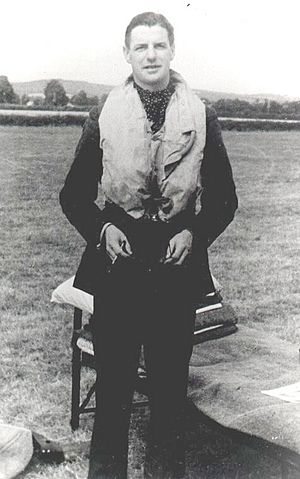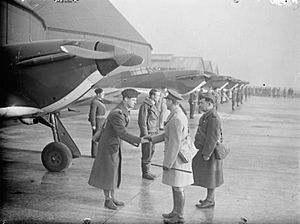John Dewar (RAF officer) facts for kids
Quick facts for kids
John Scatliff Dewar
|
|
|---|---|

Exeter Airfield, summer 1940
|
|
| Born | 10 August 1907 Lahore, British India |
| Died | 11 September 1940 (aged 33) English Channel, off Selsey Bill, Sussex, England |
| Allegiance | |
| Service/ |
|
| Years of service | 1926–1941 |
| Rank | Wing Commander |
| Commands held | No. 87 Squadron RAF, Exeter Wing |
| Battles/wars | World War II |
| Awards | Distinguished Service Order Distinguished Flying Cross |
| Other work | Rolls-Royce |
John Scatliff Dewar was a brave Royal Air Force fighter pilot during World War II. He was known for his courage and leadership. Sadly, he was killed in action during the famous Battle of Britain in 1940. He received two important awards for his bravery: the Distinguished Service Order (DSO) and the Distinguished Flying Cross (DFC).
Contents
Early Life and School
John Scatliff Dewar was born on August 10, 1907, in Lahore, which was then part of British India. His father, Douglas Dewar, worked for the Indian Civil Service.
John went to The King's School, Canterbury in England. He was a very active student. He was a School Monitor, which is like a student leader. He also played on the school's cricket and rugby teams. John was part of the school's Officer Training Corps, where he became a Sergeant. He even helped edit the school magazine, The Cantuarian.
Joining the Royal Air Force
In 1926, John Dewar joined the Royal Air Force College Cranwell. This was a special college for training future RAF officers. After graduating in 1927, he became a Pilot Officer. His first job was with No. 13 Army Co-operation Squadron.
He quickly moved up the ranks. In 1929, he became a Flying Officer. He also became a qualified flying instructor, teaching others how to fly.
Flying with the Fleet
In 1933, John joined No. 822 Fleet Spotter/Reconnaissance. This was an RAF flight that worked closely with the Navy. He served on HMS Furious, a large aircraft carrier. He sailed with the Home Fleet and in the Mediterranean Sea. Once, he was even washed overboard in the Bay of Biscay but was rescued!
He became a Flight Lieutenant in 1934 while sailing in the Caribbean. Later that year, he moved to No. 801 Fleet Fighter Squadron.
Helping Develop New Planes
From 1936 to 1938, Dewar worked at a special testing center called the Aeroplane and Armament Experimental Establishment (A&AEE). Here, he helped test and develop early versions of two very famous fighter planes: the Hawker Hurricane and the Supermarine Spitfire. These planes would become super important during World War II.
In 1938, he was promoted to Squadron Leader. He then became the Senior Operations Officer at Thorney Island. By November 1939, he was one of the most experienced pilots in the RAF.
Family Life
On July 10, 1937, John Dewar married Kathleen "Kay" Bowyer. Kay was the daughter of a politician from Southampton. They did not have any children.
World War II Hero

In November 1939, John Dewar was given command of No. 87 Squadron RAF. He led his squadron during the Battle of France in 1940. He showed amazing flying skills and leadership.
An Injury and Continued Bravery
On May 7, 1940, John was flying his Hurricane back from a mission in bad weather. He was low on fuel and had to land at an airfield that wasn't ready for planes. When he touched down, his wheels got stuck in the mud, and his plane flipped over. He badly injured his right shoulder.
Even with his injury, he refused to stop flying. He continued to lead his squadron. On May 11, he helped shoot down a German Dornier Do 17 plane and two Junkers Ju 87s. The next day, he shot down another Ju 87. For his bravery and leadership, he was awarded the Distinguished Service Order (DSO).
On May 20, 1940, as the German army advanced, Dewar ordered his squadron to return to England.
Awards for Gallantry
John Dewar received the Distinguished Flying Cross on May 31, 1940. The award recognized his skill in shooting down five enemy aircraft and leading many patrols with courage.
On the same day, he also received the Distinguished Service Order. This award highlighted his incredible determination. Even with his injured shoulder, he flew regularly and led his squadron with great skill. His squadron destroyed more than 60 enemy aircraft under his command. He kept his squadron's spirits high and trained new pilots well.
The Battle of Britain
Dewar continued to fly with No. 87 Squadron from RAF Exeter during the Battle of Britain. This was a huge air battle over Britain in the summer and autumn of 1940. He shot down two Bf 110 fighters on July 11. He also helped destroy a Ju 88 on August 13 and destroyed another Ju 88 on August 25.
On September 1, 1940, he was promoted to Wing Commander. He then became the commanding officer of RAF Exeter.
Final Flight
On September 11, 1940, Wing Commander Dewar took off from RAF Exeter. He was flying a Hurricane plane to RAF Tangmere for a meeting and to visit his wife. However, he never arrived.
He was the highest-ranking RAF officer to be lost during the Battle of Britain. It is believed he flew into a battle between German planes and Hurricanes from 213 Squadron. He was flying a 213 Squadron plane and likely heard the fight on his radio. Being a brave pilot, he probably decided to join the action.
His body was found washed ashore on September 30, 1940, in Sussex. Reports suggest he was hit by machine-gun fire, possibly while in his cockpit.
John Scatliff Dewar is buried at St John the Baptist church in North Baddesley, Hampshire. He is remembered as a true hero of World War II.
Images for kids


